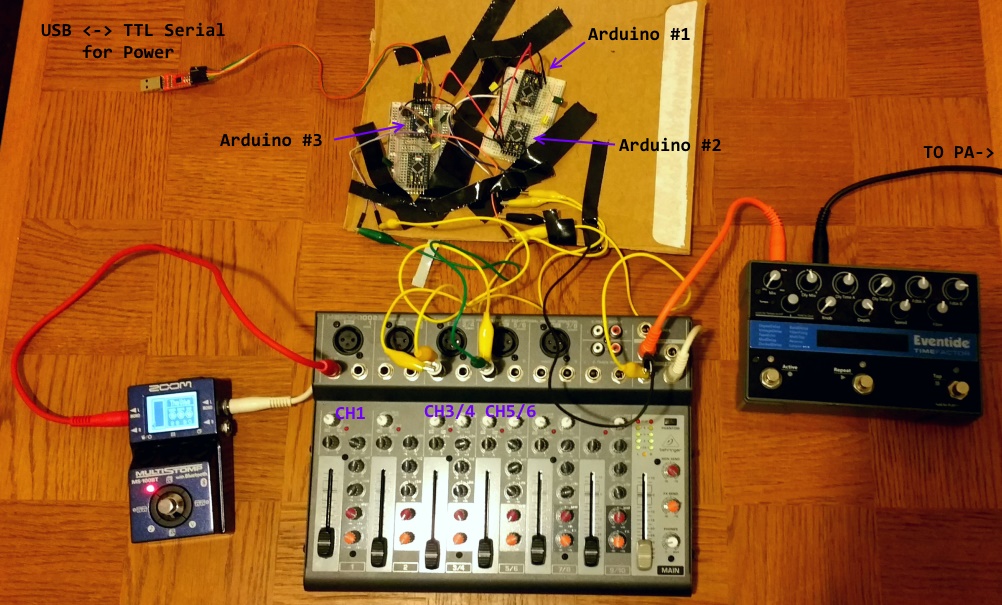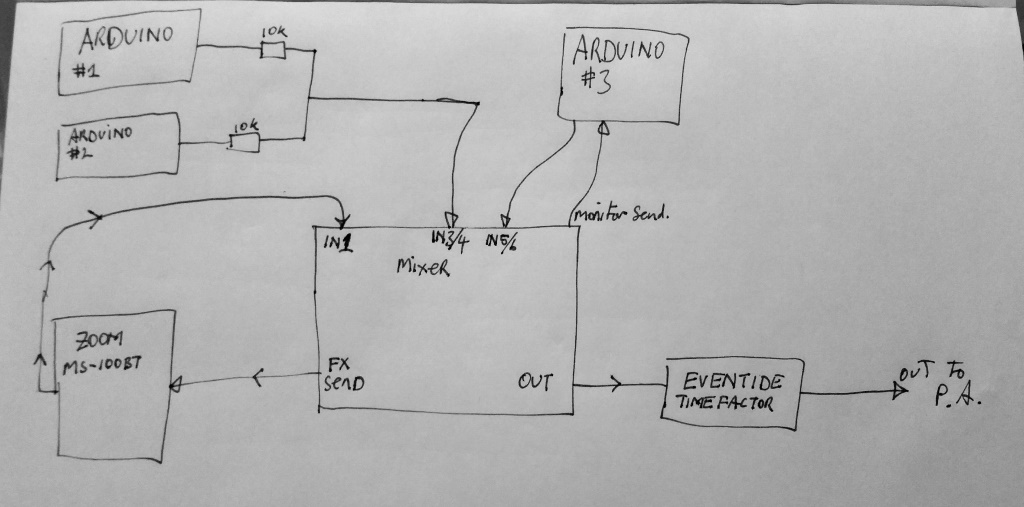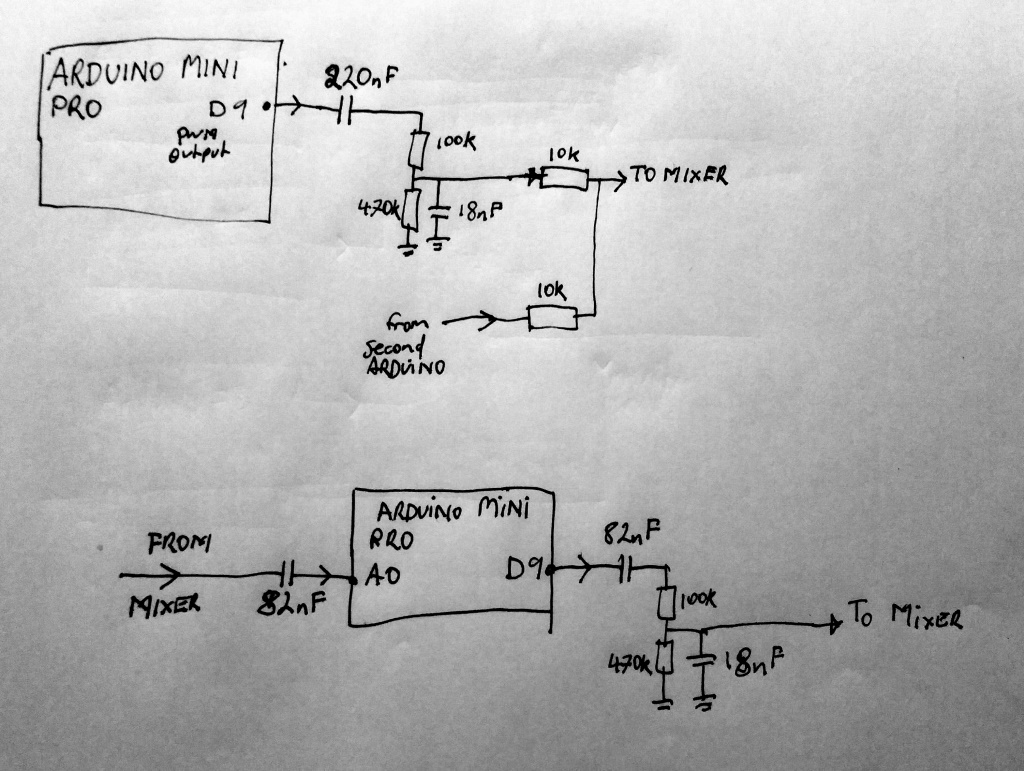



/** * Sketch_jun26d AotD drones #1 * must be compiled with USE_AUDIO_INPUT disabled */ #include <MozziGuts.h> #include <Oscil.h> #include <tables/sin2048_int8.h> // sine table for oscillator #include <mozzi_fixmath.h> #include <Line.h> #include <WaveShaper.h> #include <tables/waveshape_compress_512_to_488_int16.h> #define CONTROL_RATE 64 // powers of 2 please // 2 oscillators to compare linear interpolated vs smoothed control Oscil <SIN2048_NUM_CELLS, AUDIO_RATE> aSin0(SIN2048_DATA); //F1 Oscil <SIN2048_NUM_CELLS, AUDIO_RATE> bSin0(SIN2048_DATA); //F2 Oscil <SIN2048_NUM_CELLS, AUDIO_RATE> cSin0(SIN2048_DATA); //F3 Oscil <SIN2048_NUM_CELLS, AUDIO_RATE> dSin0(SIN2048_DATA); //F4 Oscil <SIN2048_NUM_CELLS, AUDIO_RATE> eSin0(SIN2048_DATA); //F5 Oscil <SIN2048_NUM_CELLS, AUDIO_RATE> fSin0(SIN2048_DATA); //F6 Oscil <SIN2048_NUM_CELLS, AUDIO_RATE> gSin0(SIN2048_DATA); //F7 Oscil <SIN2048_NUM_CELLS, AUDIO_RATE> hSin0(SIN2048_DATA); //F8 Oscil <SIN2048_NUM_CELLS, AUDIO_RATE> iSin0(SIN2048_DATA); //F9 Oscil <SIN2048_NUM_CELLS, AUDIO_RATE> jSin0(SIN2048_DATA); //F10 WaveShaper <int> aCompress(WAVESHAPE_COMPRESS_512_TO_488_DATA); // to compress instead of dividing by 2 after adding signals Line <Q16n16> aInterpolate; Line <Q16n16> bInterpolate; Line <Q16n16> cInterpolate; Line <Q16n16> dInterpolate; Line <Q16n16> eInterpolate; Line <Q16n16> fInterpolate; Line <Q16n16> gInterpolate; Line <Q16n16> hInterpolate; Line <Q16n16> iInterpolate; Line <Q16n16> jInterpolate; // the number of audio steps the line has to take to reach the next control value const unsigned int AUDIO_STEPS_PER_CONTROL = 64;//AUDIO_RATE / CONTROL_RATE; const int FIVE_MINS = CONTROL_RATE*5*60; int runtime =0; float f1_freq; #define F1START 22.5f #define F1END 110.1f #define F2START 10.f #define F2END 220.f #define F3START 440.f #define F3END 110.2f #define F4START 880.f #define F4END 109.9f #define F5START 28.f #define F5END 110.01f #define F6START 165.f #define F6END 111.1f #define F7START 330.f #define F7END 109.21f #define F8START 999.f #define F8END 109.5f #define F9START 345.f #define F9END 109.91f #define F10START 550.f #define F10END 55.1f void setup() { // put your setup code here, to run once: Serial.begin(115200); runtime = 0; //set up frequency lines aInterpolate.set(float_to_Q16n16(F1START),float_to_Q16n16(F1END),FIVE_MINS); bInterpolate.set(float_to_Q16n16(F2START),float_to_Q16n16(F2END),FIVE_MINS); cInterpolate.set(float_to_Q16n16(F3START),float_to_Q16n16(F3END),FIVE_MINS); dInterpolate.set(float_to_Q16n16(F4START),float_to_Q16n16(F4END),FIVE_MINS); eInterpolate.set(float_to_Q16n16(F5START),float_to_Q16n16(F5END),FIVE_MINS); fInterpolate.set(float_to_Q16n16(F6START),float_to_Q16n16(F6END),FIVE_MINS); gInterpolate.set(float_to_Q16n16(F7START),float_to_Q16n16(F7END),FIVE_MINS); hInterpolate.set(float_to_Q16n16(F8START),float_to_Q16n16(F8END),FIVE_MINS); iInterpolate.set(float_to_Q16n16(F9START),float_to_Q16n16(F9END),FIVE_MINS); jInterpolate.set(float_to_Q16n16(F10START),float_to_Q16n16(F10END),FIVE_MINS); startMozzi(CONTROL_RATE); } void updateControl(){ if(runtime % 64 ==0){ Serial.print("runtime \t");Serial.println(runtime); } //if we have ended. if(runtime > FIVE_MINS){ aInterpolate.set(float_to_Q16n16(F1END),float_to_Q16n16(F1END),FIVE_MINS); bInterpolate.set(float_to_Q16n16(F2END),float_to_Q16n16(F2END),FIVE_MINS); cInterpolate.set(float_to_Q16n16(F3END),float_to_Q16n16(F3END),FIVE_MINS); dInterpolate.set(float_to_Q16n16(F4END),float_to_Q16n16(F4END),FIVE_MINS); eInterpolate.set(float_to_Q16n16(F5END),float_to_Q16n16(F5END),FIVE_MINS); fInterpolate.set(float_to_Q16n16(F6END),float_to_Q16n16(F6END),FIVE_MINS); gInterpolate.set(float_to_Q16n16(F7END),float_to_Q16n16(F7END),FIVE_MINS); hInterpolate.set(float_to_Q16n16(F8END),float_to_Q16n16(F8END),FIVE_MINS); iInterpolate.set(float_to_Q16n16(F9END),float_to_Q16n16(F9END),FIVE_MINS); jInterpolate.set(float_to_Q16n16(F10END),float_to_Q16n16(F10END),FIVE_MINS); Serial.println("end line"); //probs should turn on red LED here. } aSin0.setFreq_Q16n16(aInterpolate.next()); bSin0.setFreq_Q16n16(bInterpolate.next()); cSin0.setFreq_Q16n16(cInterpolate.next()); dSin0.setFreq_Q16n16(dInterpolate.next()); eSin0.setFreq_Q16n16(eInterpolate.next()); fSin0.setFreq_Q16n16(fInterpolate.next()); gSin0.setFreq_Q16n16(gInterpolate.next()); hSin0.setFreq_Q16n16(hInterpolate.next()); iSin0.setFreq_Q16n16(iInterpolate.next()); jSin0.setFreq_Q16n16(jInterpolate.next()); runtime++; } int updateAudio(){ int snd = (int)(aSin0.next()+bSin0.next()+cSin0.next() + dSin0.next() )>>2; int snd2 = (int)(eSin0.next() +fSin0.next() +gSin0.next()+hSin0.next() + iSin0.next() + jSin0.next())>>3; return aCompress.next(256u + snd + snd2); } void loop() { // put your main code here, to run repeatedly: audioHook(); } |
1 2 3 4 5 6 7 8 9 10 11 12 13 14 15 16 17 18 19 20 21 22 23 24 25 26 27 28 29 30 31 32 33 34 35 36 37 38 39 40 41 42 43 44 45 46 47 48 49 50 51 52 53 54 55 56 57 58 59 60 61 62 63 64 65 66 67 68 69 70 71 72 73 74 75 76 77 78 79 80 81 82 83 84 85 86 87 88 89 90 91 92 93 94 95 96 97 98 99 100 101 102 103 104 105 106 107 108 109 110 111 112 113 114 115 116 117 118 119 120 121 122 123 124 125 126 127 128 129 130 131 132 133 134 135 136 137 138 139 |
/** * Sketch_jun26e AotD drones #2 * must be compiled with USE_AUDIO_INPUT disabled */ #include <MozziGuts.h> #include <Oscil.h> #include <tables/sin2048_int8.h> // sine table for oscillator #include <mozzi_fixmath.h> #include <Line.h> #include <WaveShaper.h> #include <tables/waveshape_compress_512_to_488_int16.h> #define CONTROL_RATE 64 // powers of 2 please Oscil <SIN2048_NUM_CELLS, AUDIO_RATE> aSin0(SIN2048_DATA); //F1 Oscil <SIN2048_NUM_CELLS, AUDIO_RATE> bSin0(SIN2048_DATA); //F2 Oscil <SIN2048_NUM_CELLS, AUDIO_RATE> cSin0(SIN2048_DATA); //F3 Oscil <SIN2048_NUM_CELLS, AUDIO_RATE> dSin0(SIN2048_DATA); //F4 Oscil <SIN2048_NUM_CELLS, AUDIO_RATE> eSin0(SIN2048_DATA); //F5 Oscil <SIN2048_NUM_CELLS, AUDIO_RATE> fSin0(SIN2048_DATA); //F6 Oscil <SIN2048_NUM_CELLS, AUDIO_RATE> gSin0(SIN2048_DATA); //F7 Oscil <SIN2048_NUM_CELLS, AUDIO_RATE> hSin0(SIN2048_DATA); //F8 Oscil <SIN2048_NUM_CELLS, AUDIO_RATE> iSin0(SIN2048_DATA); //F9 Oscil <SIN2048_NUM_CELLS, AUDIO_RATE> jSin0(SIN2048_DATA); //F10 WaveShaper <int> aCompress(WAVESHAPE_COMPRESS_512_TO_488_DATA); // to compress instead of dividing by 2 after adding signals // Line to interpolate frequency for aSin0. Line <Q16n16> aInterpolate; Line <Q16n16> bInterpolate; Line <Q16n16> cInterpolate; Line <Q16n16> dInterpolate; Line <Q16n16> eInterpolate; Line <Q16n16> fInterpolate; Line <Q16n16> gInterpolate; Line <Q16n16> hInterpolate; Line <Q16n16> iInterpolate; Line <Q16n16> jInterpolate; // the number of audio steps the line has to take to reach the next control value const unsigned int AUDIO_STEPS_PER_CONTROL = 64;//AUDIO_RATE / CONTROL_RATE; const int FIVE_MINS = CONTROL_RATE*5*60; int runtime =0; float f1_freq; #define F1START 898.5f #define F1END 22.251f #define F2START 999.f #define F2END 165.f #define F3START 1300.f #define F3END 165.2f #define F4START 2134.f #define F4END 164.5f #define F5START 10.f #define F5END 165.01f #define F6START 2290.f #define F6END 111.1f #define F7START 2322.f #define F7END 82.21f #define F8START 999.f #define F8END 82.5f #define F9START 1400.f #define F9END 82.91f #define F10START 700.f #define F10END 165.1f void setup() { // put your setup code here, to run once: Serial.begin(115200); runtime = 0; //set up frequency lines aInterpolate.set(float_to_Q16n16(F1START),float_to_Q16n16(F1END),FIVE_MINS); bInterpolate.set(float_to_Q16n16(F2START),float_to_Q16n16(F2END),FIVE_MINS); cInterpolate.set(float_to_Q16n16(F3START),float_to_Q16n16(F3END),FIVE_MINS); dInterpolate.set(float_to_Q16n16(F4START),float_to_Q16n16(F4END),FIVE_MINS); eInterpolate.set(float_to_Q16n16(F5START),float_to_Q16n16(F5END),FIVE_MINS); fInterpolate.set(float_to_Q16n16(F6START),float_to_Q16n16(F6END),FIVE_MINS); gInterpolate.set(float_to_Q16n16(F7START),float_to_Q16n16(F7END),FIVE_MINS); hInterpolate.set(float_to_Q16n16(F8START),float_to_Q16n16(F8END),FIVE_MINS); iInterpolate.set(float_to_Q16n16(F9START),float_to_Q16n16(F9END),FIVE_MINS); jInterpolate.set(float_to_Q16n16(F10START),float_to_Q16n16(F10END),FIVE_MINS); startMozzi(CONTROL_RATE); } void updateControl(){ if(runtime % 64 ==0){ Serial.print("runtime \t");Serial.println(runtime); } //if we have ended. if(runtime > FIVE_MINS){ aInterpolate.set(float_to_Q16n16(F1END),float_to_Q16n16(F1END),FIVE_MINS); bInterpolate.set(float_to_Q16n16(F2END),float_to_Q16n16(F2END),FIVE_MINS); cInterpolate.set(float_to_Q16n16(F3END),float_to_Q16n16(F3END),FIVE_MINS); dInterpolate.set(float_to_Q16n16(F4END),float_to_Q16n16(F4END),FIVE_MINS); eInterpolate.set(float_to_Q16n16(F5END),float_to_Q16n16(F5END),FIVE_MINS); fInterpolate.set(float_to_Q16n16(F6END),float_to_Q16n16(F6END),FIVE_MINS); gInterpolate.set(float_to_Q16n16(F7END),float_to_Q16n16(F7END),FIVE_MINS); hInterpolate.set(float_to_Q16n16(F8END),float_to_Q16n16(F8END),FIVE_MINS); iInterpolate.set(float_to_Q16n16(F9END),float_to_Q16n16(F9END),FIVE_MINS); jInterpolate.set(float_to_Q16n16(F10END),float_to_Q16n16(F10END),FIVE_MINS); Serial.println("end line"); //this makes some nice glitching sounds after the 5minute mark //probs should turn on red LED here. } aSin0.setFreq_Q16n16(aInterpolate.next()); bSin0.setFreq_Q16n16(bInterpolate.next()); cSin0.setFreq_Q16n16(cInterpolate.next()); dSin0.setFreq_Q16n16(dInterpolate.next()); eSin0.setFreq_Q16n16(eInterpolate.next()); fSin0.setFreq_Q16n16(fInterpolate.next()); gSin0.setFreq_Q16n16(gInterpolate.next()); hSin0.setFreq_Q16n16(hInterpolate.next()); iSin0.setFreq_Q16n16(iInterpolate.next()); jSin0.setFreq_Q16n16(jInterpolate.next()); runtime++; } int updateAudio(){ int snd = (int)(aSin0.next()+bSin0.next()+cSin0.next() + dSin0.next() )>>2; int snd2 = (int)(eSin0.next() +fSin0.next() +gSin0.next()+hSin0.next() + iSin0.next() + jSin0.next())>>3; return aCompress.next(256u + snd + snd2); } void loop() { // put your main code here, to run repeatedly: audioHook(); } |
1 2 3 4 5 6 7 8 9 10 11 12 13 14 15 16 17 18 19 20 21 22 23 24 25 26 27 28 29 30 31 32 33 34 35 36 37 38 |
/** * Jun27a Reverb Code. ReverTank.h needs to be changed to fit into the memory of the Pro Mini */ #include <MozziGuts.h> #include <ReverbTank.h> #include <tables/waveshape_compress_512_to_488_int16.h> #include <WaveShaper.h> WaveShaper <int> aCompress(WAVESHAPE_COMPRESS_512_TO_488_DATA); ReverbTank reverb; #define CONTROL_RATE 64 void setup() { // put your setup code here, to run once: startMozzi(CONTROL_RATE); } void updateControl(){ return; } int updateAudio(){ int asig = getAudioInput(); // range 0-1023 asig = asig - 512; // now range is -512 to 511 asig >>= 2; // now it's -128 to 127, within audio output range // use a waveshaping table to squeeze 2 summed 8 bit signals into the range -244 to 243 int awaveshaped3 = aCompress.next(256u + asig); int arev = reverb.next(awaveshaped3); return arev; } void loop() { // put your main code here, to run repeatedly: audioHook(); } |
